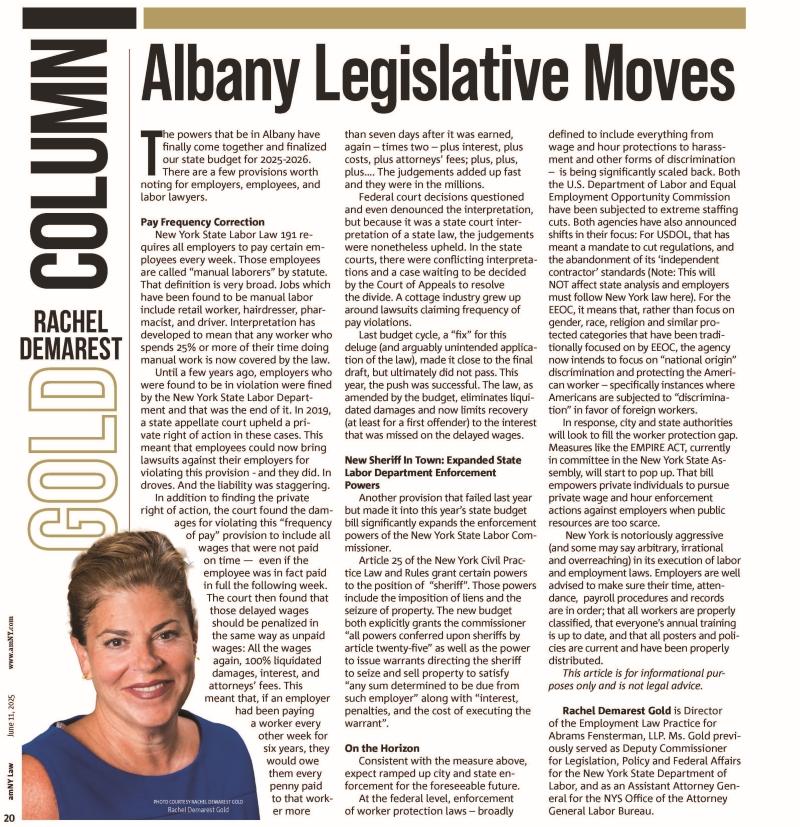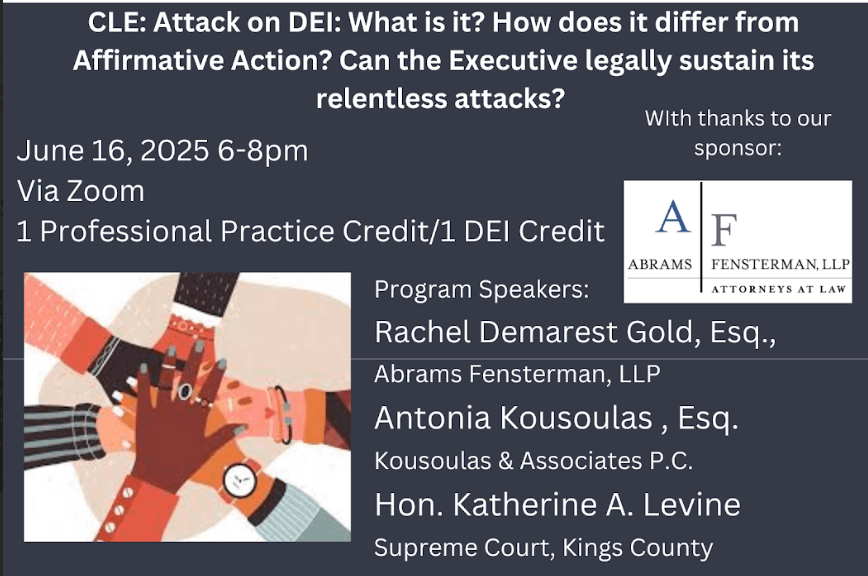By Christopher Gorman, John Muldoon and Robert Marx for Law 360 Expert Analysis (July 17, 2023)
Since its passage on Dec. 31, 2022, the Foreclosure Prevention Act has already become one of the most foremost issues in the world of New York state foreclosure law.
Parties on both sides of the litigation spectrum — whether they be lenders or borrowers — have actively litigated the provisions of FAPA in state, federal and appellate courts, arguing, among other hot-button issues, the constitutionality of FAPA and whether FAPA applies retroactively to cases that were pending prior to the statute’s enactment.
Both critics and supporters of FAPA have been vocal — and whether one interprets FAPA as a remedial measure rationally related to a legitimate government interest to reverse lenders’ manipulation of the statute of limitations, as borrowers tend to argue, or as a statute that ignores precedent and changes the rules to create an unconstitutional retroactive taking of a mortgagee’s vested property rights, as lenders tend to argue — probably depends on which side of the caption a party finds itself.
To date, the Appellate Division, Second Department, has not addressed the constitutionality arguments raised by litigants in FAPA cases head-on. Instead, the Second Department has expressly indicated that it is awaiting full briefing and decision on those issues in the lower courts before issuing a definitive ruling on the subject.
On May 17, in U.S. Bank v. Simon, the Second Department noted that, while “the plaintiff challenges the constitutionality of FAPA, contending, inter alia, that FAPA violates the Due Process Clause and the Contract Clause of the United States Constitution,” it was also faced with the countervailing argument in the case made by “[t]he defendant and the Attorney General, as intervenor, … that FAPA is constitutional.”[1]
Despite the arguments made by the parties on the issue of FAPA’s constitutionality, the Second Department nonetheless concluded that insofar “as the Supreme Court did not consider the issues relating to the constitutionality of FAPA in determining the subject branches of the defendant’s motion, we remit the matter to the Supreme Court, Queens County, for consideration thereof.”
One would think, therefore, given the Second Department’s decision to stay out of the fray in Simon, at least for now, with respect to the constitutionality and retroactive application of FAPA, the court would not be actively applying FAPA in cases pending before it. The exact opposite, however, is what has occurred in the wake of Simon.
Indeed, what the Second Department has done is to continue to apply FAPA to cases before it even after declining to address the constitutionality of FAPA in Simon.
Thus, by way of example, in ARCPE 1 LLC v. DeBrosse, in a case that had been pending in the New York Supreme Court since 2016 — i.e., long prior to FAPA’s enactment — the Second Department held that FAPA’s amendment to add Civil Practice Law and Rule 3217(e), which states that the voluntary discontinuance of a prior action shall not, in form or effect, “waive, postpone, cancel, toll, extend, revive or reset the limitations period to commence an action,” applied to the case before it and held that the plaintiff’s complaint was time-barred.[2]
Similarly, in Deutsche Bank National Trust Company v. Natal, a decision which also post-dates Simon, the Second Department once again held that FAPA’s amendment to CPLR 3217(e) applied to an action that had been pending in the Supreme Court since 2017, and held that the plaintiff’s voluntarily discontinuance of a prior action was dispositive, rendering its current action untimely.
In neither DeBrosse or Natal, however, did the Second Department address any of the constitutional or retroactivity issues surrounding FAPA.[3]
Indeed, by our count, there have been at least six decisions issued by the Second Department either on the same day as Simon or since the issuance of Simon in which the Second Department, without deciding the constitutionality of FAPA, has applied FAPA to the facts in the cases before it under circumstances where the underlying foreclosure action has been pending since prior to the enactment of FAPA.
In other words, the Second Department is regularly applying FAPA retroactively, while to this point having expressly declined to address the constitutionality of doing so.[4]
The Second Department’s jurisprudence in interpreting FAPA, therefore, can only be seen as sending mixed signals to the lower court bench and New York state bar.
On the one hand, one could conclude that the Second Department’s decisions interpreting and applying FAPA will likely result in a favorable ruling from the Second Department upholding the statute’s constitutionality and retroactive application.
Indeed, it is difficult to argue that FAPA is unconstitutional and does not apply retroactively when the Second Department is regularly applying the statute in written decisions involving cases that were pending long prior to the statute’s enactment.
On the other hand, the Second Department’s resistance to wading into the FAPA constitutionality waters, as evidenced in Simon, should give one pause in concluding that the Second Department is fully prepared to declare the statute constitutional.
Mixed signals from an appellate court, however, generally speaking lead to mixed decisions from lower state and federal courts forced to grapple with the issues of FAPA’s constitutionality and retroactive application with no appellate guidance. To date, that is exactly what one sees when one analyzes the lower state and federal court decisions interpreting FAPA.
On the one hand is a series of decisions from New York state trial courts stating that the main FAPA issues that have been litigated thus far, including the statute’s retroactivity and constitutionality, have already been decided by the Appellate Division since the Appellate Division is regularly applying the statute retroactively.
Courts in this line of decisions, therefore, view the Second Department’s decisions applying
FAPA in cases that predate the statute’s enactment as binding upon them to do the exact same in the cases pending before them.[5]
On the other hand, other trial court decisions have taken the Appellate Division’s silence on the constitutionality and retroactive application of FAPA as an opening for the lower courts to decide these hot-button FAPA issues for themselves, effectively writing on a blank slate.
In at least some of these decisions, lower courts have concluded that FAPA is unconstitutional and is not entitled to retroactive application as if the Appellate Division has never spoken on these subjects, which, at least in terms of expressly dealing with these issues, is not incorrect.[6]
And, not to be outdone, in one of the leading decisions courts have relied upon in upholding the constitutionality and retroactive application of FAPA, the U.S. District Court for the Eastern District of New York has held in East Fork Funding v. U.S. Bank in March that FAPA is constitutional and does not violate the contracts clause of the U.S. Constitution.[7]
In short, until there is concrete appellate guidance on these FAPA-related issues, the split in decisions between trial courts is only likely to deepen. Such a division in authority, of course, is only going to lead to uncertainty and more litigation until these constitutional and retroactivity issues are resolved.
Such a division in authority is also likely to result in FAPA itself being applied in a divergent way court by court, with inconsistent results being attained depending entirely upon the judge before whom a particular case is being litigated.
Such inconsistencies in the application of FAPA create tremendous difficulty for attorneys, regardless of who they represent — whether it be lenders or borrowers — to advise their clients on the predictability of outcomes and results in pending litigation.
For instance, counsel may be able to advise a client that they expect a certain result in one county or before one judge because the decisions in that county or before that one judge tend to lean in one direction, whereas in another county the analysis may be the exact opposite if that court or judge has decisions on FAPA leaning in the other direction.
Until there is definitive appellate guidance, therefore, counsel and litigants will be left to their own devices to persuade the lower courts which line of reasoning should be employed in any given case involving these hot-button FAPA issues. So long as that is the playing field, practitioners can only expect to see more inconsistent results and uncertain litigation outcomes.
The good news, however, is that the FAPA constitutionality and retroactivity issues are teed up to be addressed by the Appellate Division, Third Department, in Deutsche Bank v. DeLuca, which is scheduled for oral argument in the September 2023 term.
Given the deepening split in authority outlined herein, both counsel and litigants eagerly await anticipated guidance from the Third Department in the very near future.
[1] 216 A.D.3d 1041, — N.Y.S.3d — (2d Dep’t 2023).
[2] — A.D.3d , — N.Y.S.3d —, 2023 WL 4219398 (2d Dep’t June 28, 2023).
[3] — A.D.3d , — N.Y.S.3d —, 2023 WL 4095785 (2d Dep’t June 21, 2023).
[4] See DeBrosse, 2023 WL 4219398; Natal, 2023 WL 4095785; US Bank, National Association v. Onuoha, 162 A.D.3d 1094, 80 N.Y.S.3d 331 (2d Dep’t 2023); SYCP. LLC v. Evans, — A.D.3d —, — N.Y.S.3d —, 2023 WL 3856264 (2d Dep’t June 7, 2023); U.S. Bank National Association v. Outlaw, — A.D.3d —, —N.Y.S.3d —, 2023 WL 3856269 (2d Dep’t June 7, 2023); MTGLQ Investors, L.P. v. Singh, 216 A.D.3d 1087, — N.Y.S.3d —- (2d Dep’t 2023).
[5] See e.g., Wells Fargo Bank, N.A., v. Haq (Sup. Ct. Richmond Cnty. June 8, 2023; Index No.135486/2017) (“In the Court’s view, the issue of the application of FAPA to cases such as this one has been determined by the Second Department….”).
[6] See, e.g., HSBC Bank USA, N.A. v. Besharat, 2023 NY Slip Op 23156, 2023 WL 3555407 (Sup. Ct. Putnam Cnty. May 19, 2023).
[7] East Fork Funding v. United States Bank, 20-cv-3404, 2023 WL 2660645 (E.D.N.Y. March 23, 2023).
Christopher A. Gorman is a partner and the director of the real estate and construction litigation department at Abrams Fensterman LLP. John Muldoon is an associate at the firm. Robert Marx is an independent litigation support analyst awaiting admission to the New York state bar. The opinions expressed are those of the author(s) and do not necessarily reflect the views of their employer, its clients, or Portfolio Media Inc., or any of its or their respective affiliates.
This article is for general information purposes and is not intended to be and should not be taken as legal advice.
Reprinted with permission from Law360. All rights reserved. Further duplication without permission is prohibited. Law 360 Reprints – [email protected].





